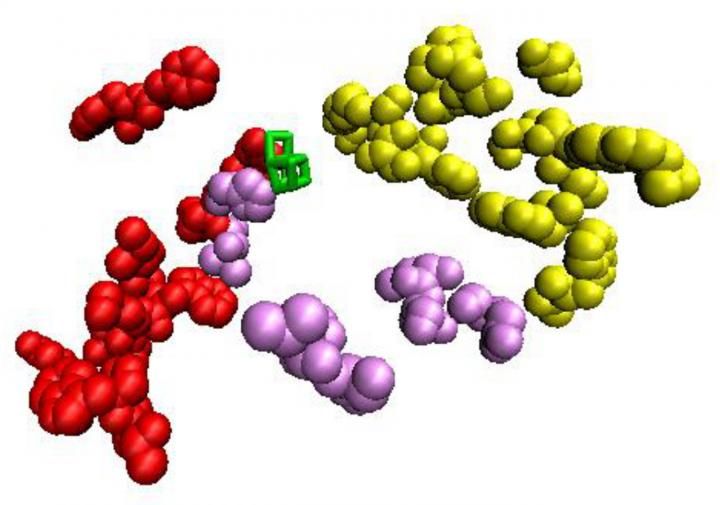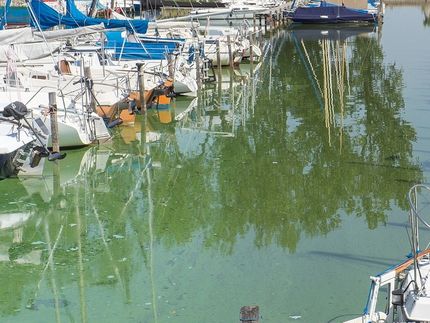Water world
Researchers at Washington University in St. Louis have traced the paths of three water channels in an ancient photosynthetic organism to provide the first comprehensive, experimental study of how that organism uses and regulates water to create energy.

The three-colored formations (red, purple, yellow) are the three groups of damaged amino acids in Photosystem II identified in this study. They are centered on the active site ("Mn cluster," shown in green), and trace three pathways connecting the Mn cluster to the surface of the complex, the watery bulk medium of the cell.
Science Advances manuscript # aao3013, Figure 3B.
Photosynthesis is the chemical conversion of sunlight into chemical energy via an electron transport chain essential to nearly all life on our planet. All plants operate by photosynthesis, as do algae and certain varieties of bacteria.
Himadri B. Pakrasi, Myron and Sonya Glassberg/Albert and Blanche Greensfelder University Distinguished Professor and Director, International Center for Energy, Environment and Sustainability, post-doctoral researcher Daniel A. Weisz , and Michael L. Gross , professor of chemistry, studied the great granddaddy of all photosynthetic organisms -- a strain of cyanobacteria -- to develop the first experimental map of that organism's water world.
The finding advances photosynthesis research but also presents an advance in green fuels research:
To convert sunlight into a usable form of energy, photosynthetic organisms require water at the "active site" of the Photosystem II protein complex. But the channels through which water arrives at the active site are difficult to measure experimentally. Reactive oxygen species are produced at the active site and travel away from it, in the opposite direction as water, leaving a "damage trail" in their wake.
"We identified the damaged sites in Photosystem II using high-resolution mass spectrometry and found that they reveal several pathways centered on the active site and leading away from it all the way to the surface of the complex," said Weisz. "We propose that these pathways represent channels within the complex that could be used to deliver water to the active site."
"Photosystem II has a very complex mechanism, and it's really important to understand its processes and evolution," said Pakrasi, who has researched cyanobacteria extensively for more than 25 years. "There is a growing interest in green energy, and our knowledge of this enzyme's behavior could someday be put to use to create an artificial system that mimics the real enzyme to produce an abundant amount of sustainable energy."
The active site of Photosystem II is a cluster of manganese, calcium and oxygen ions buried deep within the complex, far away from the watery medium of the cell. Researchers have long speculated that the active site, or manganese cluster, must have a channel system, and theoretical, supercomputer-generated models tenuously have predicted their existence. But water motion is hard to characterize experimentally.
The researchers took a roundabout path to delineate the channels. The "damage trail" is comprised of 36 amino acid residues from essentially three proteins found near the manganese cluster by the highly sophisticated mass spectrometer of chemist Gross, who was Weisz's doctoral co-adviser along with Pakrasi and also is appointed to the Washington University School of Medicine for his work in mass spectrometry. These damaging reactive oxygen species, also known as radicals, emanate and disperse from the cluster outward toward the cell's watery medium. The radicals pass through Photosystem II like a tornado, attacking and damaging the nearest amino acid components of Photosystem II that they encounter along their path.
Because the radicals and water have similar properties, such as size and hydrophilicity, the researchers propose that the damage trail pathways going out from the cluster are very similar to the paths that water takes inward toward the active site.
"We're directly observing the paths that the radicals take, not those of water," Weisz said. "But given the radicals' similar properties to water as well as previous computer modeling results, we believe that those pathways are the same ones that water takes inward."
Such an approach to discovering the water channels is considered a proxy because it's based on the movement of the highly reactive radicals and not of the water itself.
The proxy, Weisz said, "is like leaving a trail of bread crumbs along a path in the forest. If someone is able to find the bread crumbs, they can retrace the path taken out of the forest."
The researchers were able to identify the many damaged residues because of the incredible accuracy, speed and sensitivity of Gross's mass spectrometry instrument. "With earlier instruments that were slower and less sensitive, it was harder to confidently identify large numbers of damaged sites," Weisz said. "The powerful capabilities of this instrument enabled us to obtain these results ."
"Cyanobacteria are the progenitors of chloroplasts in plants," Pakrasi said. "Photosystem II is conserved across all oxygenic photosynthetic organisms. We know for sure that nature devised this machine only once, then transferred it from cyanobacteria to algae and to plants."
Original publication
See the theme worlds for related content
Topic World Mass Spectrometry
Mass spectrometry enables us to detect and identify molecules and reveal their structure. Whether in chemistry, biochemistry or forensics - mass spectrometry opens up unexpected insights into the composition of our world. Immerse yourself in the fascinating world of mass spectrometry!

Topic World Mass Spectrometry
Mass spectrometry enables us to detect and identify molecules and reveal their structure. Whether in chemistry, biochemistry or forensics - mass spectrometry opens up unexpected insights into the composition of our world. Immerse yourself in the fascinating world of mass spectrometry!




























































